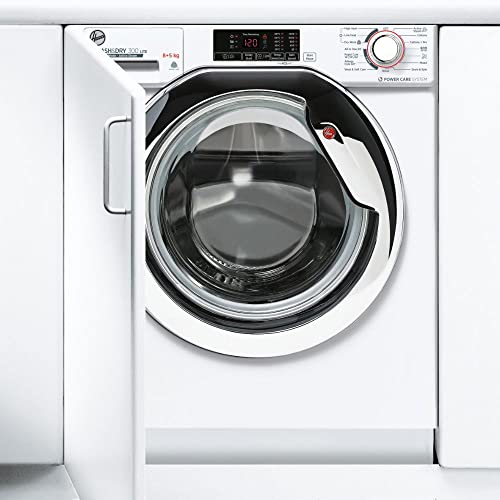Advantages of a Combination Washer and Dryer in One Unit
A washer and dryer in one unit is a fantastic option for smaller homes, apartments, condos and condominiums. Some appear like normal dryers, while others feature a ventless system that allows you to put them in without having a duct.
They are also smaller, and have less efficient drying capabilities compared to standalone appliances. They are also more complex and prone to failure than standalone appliances.
Space Savings
Combination washer and dryers are a ideal option for homes with smaller spaces that don't have enough space for separate dryer and washer units. They are also great for RVs, vacation homes and condos that have small spaces. You can also find washer/dryer combinations that are ventless, so they don't need a duct to function.
This LG combination washer and dryer has a white finish and a sleek design to be a perfect fit in any modern house. This model comes with a fast speed of rotation that helps remove water from clothes and speed up drying time. It comes with an automatic dispenser that dispenses fabric softener and laundry detergent. The dispenser automatically dispenses the correct amount of detergent based on load size, soil level and the cycle settings. The single-dose dispenser can be used to add a specific laundry detergent for a particular load.
It's important to understand that these combos of washer and dryer use condensing technology, which means they use a greater amount of water per cycle than conventional washing machines. This can result in a significant increase in your utility bills depending on the model that you select. When deciding on a washer/dryer, you should also consider your home's water and energy usage.
These compact washer-dryer combos are usually electric which means that they can be connected to any standard household outlet. They don't require a dryer vent, which saves you money on installation costs. They're also movable, which means you can transfer them from one location to another when needed.
A washer/dryer combo is more efficient than a separate dryer and washer as it can handle both at the same time. However, they're typically slower than standalone sets of washers and dryers because of their smaller drum capacity and short spinning speeds. It's essential to not overload the drum, as this can cause your clothes to become strung and tear when drying.
You have to decide which one is best for you based on your laundry habits and requirements. Both have pros and cons, so it's essential to research your options carefully before making an investment.

Convenience
One of the major advantages of a washer dryer combo is that it helps to save space. Combination units combine two standalone laundry appliances into one unit that takes up less horizontal floor space than a set that is side-by-side and less vertical space than a stacked pair. This makes them ideal for living spaces that are cramped such as apartments, mobile homes, recreational vehicles, and condos. They also make a great choice for small households that have limited storage space.
Combination units are far more sophisticated than standalone units and come with numerous features. They have touchscreen LCDs which lets you choose between drying and washing cycles. They also come with a hot water setting to sanitize the clothes, a FanFresh cycle, which spins your clothes on a regular basis for up to 12 hours after the wash cycle has ended as well as wifi integration, so you can check the status of your laundry from any location. They're also ENERGY STAR(r) certified to help reduce energy use and save you money on your utility bills over time.
The biggest drawback to combo units is that they typically not perform well when drying. The clothes are rarely completely dry after the completion of a complete wash and dry cycle. They may have to go back to the drum to dry for longer. They also consume more water, especially when drying. This can be a problem if you have tank water or are concerned about the environmental impact.
A combo unit is more complex than the standalone models. This increases the risk of an error that occurs during the operation. This can lead to an expense for repairs or even replacement of both appliances. It's not a problem when you only use one appliance, but it is when both are being used simultaneously and something goes wrong. Some experts recommend against buying the combo appliances for large families, especially those who live in multifamily housing. If, however, you're a small family with limited space and need both an efficient washer and fast-drying dryer, this appliance could be ideal for your family.
Energy Savings
The tedious chore of washing laundry can be made much more efficient by a washer and dryer combo unit. These units require you to only load the machine, select your cycle, and then return when the cycle is complete. This is an excellent option for those who are busy and don't have the time to commit to a timeframe for doing their laundry. A combination washer-dryer in one unit will save energy because it does not run two separate appliances at once. This is particularly important for those who live in areas that experience frequent power outages.
The energy savings of these units can also be due to the fact that most of them are designed with front-loading technology. This means they lift the clothes out of the water as they move around, rather than pushing them back into the water, as top-loading washing machines do. This more gentle and efficient method of washing decreases the amount of heat generated during the process.
The majority of these units will also have a specific setting for delicates, which can help reduce the amount of strain that is placed on the fabric during the drying process. This will help keep the fabrics in good condition during the drying cycle and can reduce the amount of shrinkage that happens during the process.
Another method to cut down on energy consumption is to buy an appliance with a built-in dryer vent. This allows you to skip the step of needing a venting kit, which costs anywhere from $100 to $200. Typically, these types of models are also more expensive than non-venting options.
One of the more economical and efficient ways to cut down on energy bills is by purchasing a vented washer/dryer that is ENERGY STAR certified. The ENERGY STAR certification signifies that the appliance will use less energy than comparable non-certified units which can cut down your energy bills by up to 30 percent. This option is available from several manufacturers that include LG and GE. Certain models that are newer will also allow both drying and washing in a single cycle. These are referred to as heat pump washer/dryer combinations and are the most modern options for washing and drying your clothes using an appliance that can be combined.
Durability
If you are limited in the space for laundry, the best way to maximize your utility is by upgrading to a combo washer/dryer (also called an all-in-one device). This versatile appliance is designed for apartments and condominiums. It will save you time and energy. Its ventless design requires only an outlet that is 120 volts in the standard household. This means you don't need to install a vent or use up valuable wall space with two separate appliances.
Combinations of dryer and washer are ideal for RVs and small living spaces. They're also a convenient option for households with small spaces since they require less space and water than standalone models. Apart from being space-saving, combo units are a great choice for those with an extremely tight budget because they are less expensive upfront than two separate machines.
However, if you have a large family or huge laundry requirements, you may need to think about an alternative solution. For one, these machines typically only dry and wash one load at a time which means that you cannot begin washing a new load while your clothes are drying. In addition, many of the all-in-one models come with a maximum load size that's too small to handle large loads of laundry.
Although they're cheaper than buying two separate appliances upfront, they are not the most reliable when it comes to durability. They typically contain more moving parts than standalone laundry machines, meaning they are more prone to breakdowns and malfunctions over time. Furthermore, a malfunction with one machine will interrupt both drying and washing processes until you are able to fix it. This can be a major hassle and unnecessary expense for households with busy schedules. Because of this it is important to evaluate the pros and cons of a combination washer/dryer prior to making a purchase. Jay Gaylen recommends that you look for a model with a long life and has a sufficient capacity to meet your needs. If you have any questions about a particular model do not hesitate to reach out to the manufacturer directly to get more information.
